401013 Nursing Assignment 1: Mental Health Case Study Analysis
VerifiedAdded on 2022/10/15
|10
|2714
|10
Homework Assignment
AI Summary
This nursing assignment analyzes the case of a 45-year-old Cambodian man, Munny, presenting with symptoms of depression stemming from work-related stress and the death of his mother. The assignment begins with a mental state examination, assessing Munny's appearance, behavior, speech, mood, affect, thought processes, perception, and cognition, leading to a diagnosis of depression based on DSM-5 criteria. It then applies the stress vulnerability model to understand the interplay of vulnerability and stress factors in triggering the mental health issue. Finally, the assignment explores recovery-oriented practices, emphasizing respect, empowerment, and hope, and outlines interventions such as health literacy, counseling, and motivational interviewing to facilitate Munny's recovery, referencing relevant literature throughout the analysis.

Running head: NURSING ASSIGNMENT
NURSING ASSIGNMENT’
Name of the Student:
Name of the University:
Author Note:
NURSING ASSIGNMENT’
Name of the Student:
Name of the University:
Author Note:
Paraphrase This Document
Need a fresh take? Get an instant paraphrase of this document with our AI Paraphraser
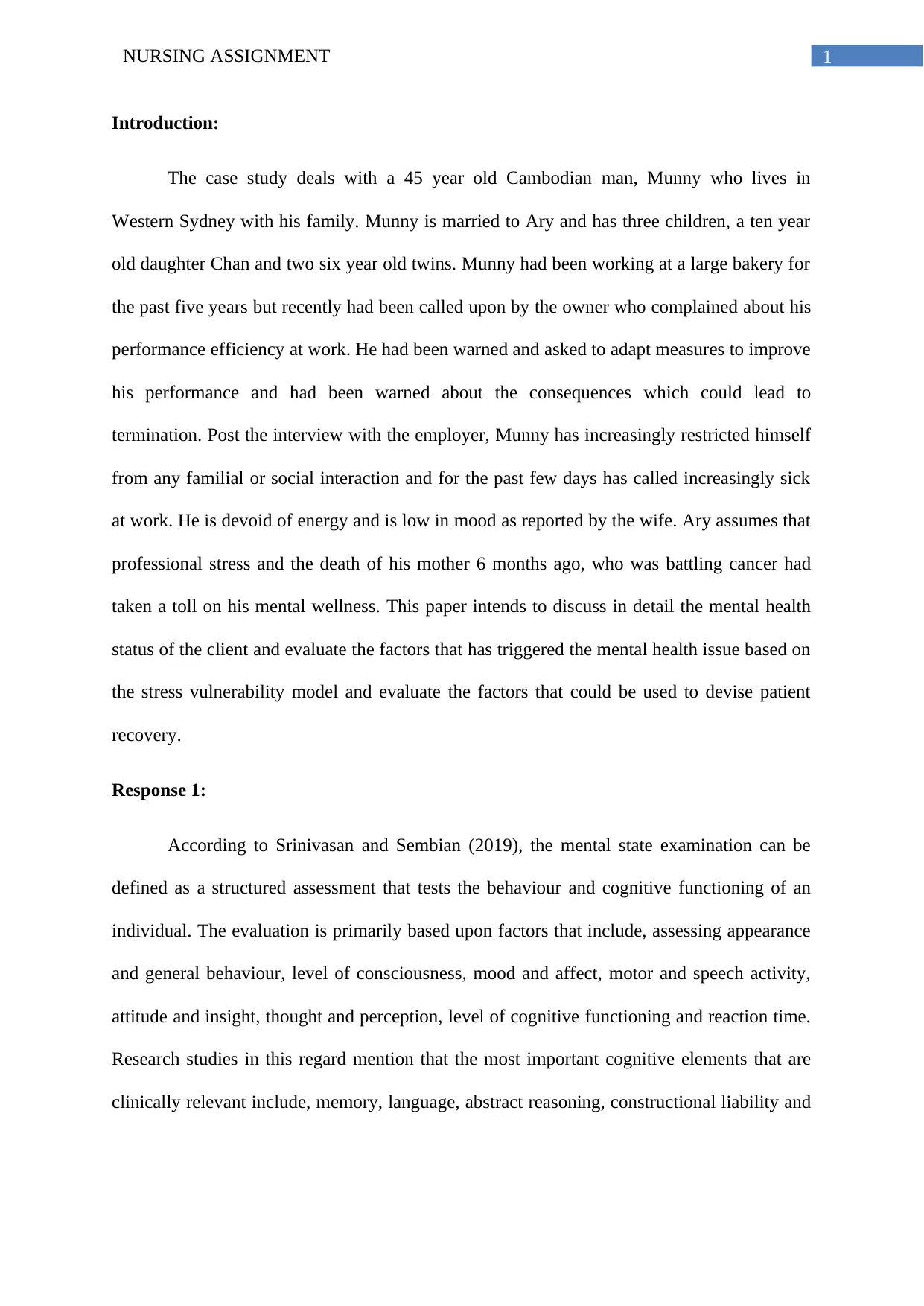
1NURSING ASSIGNMENT
Introduction:
The case study deals with a 45 year old Cambodian man, Munny who lives in
Western Sydney with his family. Munny is married to Ary and has three children, a ten year
old daughter Chan and two six year old twins. Munny had been working at a large bakery for
the past five years but recently had been called upon by the owner who complained about his
performance efficiency at work. He had been warned and asked to adapt measures to improve
his performance and had been warned about the consequences which could lead to
termination. Post the interview with the employer, Munny has increasingly restricted himself
from any familial or social interaction and for the past few days has called increasingly sick
at work. He is devoid of energy and is low in mood as reported by the wife. Ary assumes that
professional stress and the death of his mother 6 months ago, who was battling cancer had
taken a toll on his mental wellness. This paper intends to discuss in detail the mental health
status of the client and evaluate the factors that has triggered the mental health issue based on
the stress vulnerability model and evaluate the factors that could be used to devise patient
recovery.
Response 1:
According to Srinivasan and Sembian (2019), the mental state examination can be
defined as a structured assessment that tests the behaviour and cognitive functioning of an
individual. The evaluation is primarily based upon factors that include, assessing appearance
and general behaviour, level of consciousness, mood and affect, motor and speech activity,
attitude and insight, thought and perception, level of cognitive functioning and reaction time.
Research studies in this regard mention that the most important cognitive elements that are
clinically relevant include, memory, language, abstract reasoning, constructional liability and
Introduction:
The case study deals with a 45 year old Cambodian man, Munny who lives in
Western Sydney with his family. Munny is married to Ary and has three children, a ten year
old daughter Chan and two six year old twins. Munny had been working at a large bakery for
the past five years but recently had been called upon by the owner who complained about his
performance efficiency at work. He had been warned and asked to adapt measures to improve
his performance and had been warned about the consequences which could lead to
termination. Post the interview with the employer, Munny has increasingly restricted himself
from any familial or social interaction and for the past few days has called increasingly sick
at work. He is devoid of energy and is low in mood as reported by the wife. Ary assumes that
professional stress and the death of his mother 6 months ago, who was battling cancer had
taken a toll on his mental wellness. This paper intends to discuss in detail the mental health
status of the client and evaluate the factors that has triggered the mental health issue based on
the stress vulnerability model and evaluate the factors that could be used to devise patient
recovery.
Response 1:
According to Srinivasan and Sembian (2019), the mental state examination can be
defined as a structured assessment that tests the behaviour and cognitive functioning of an
individual. The evaluation is primarily based upon factors that include, assessing appearance
and general behaviour, level of consciousness, mood and affect, motor and speech activity,
attitude and insight, thought and perception, level of cognitive functioning and reaction time.
Research studies in this regard mention that the most important cognitive elements that are
clinically relevant include, memory, language, abstract reasoning, constructional liability and
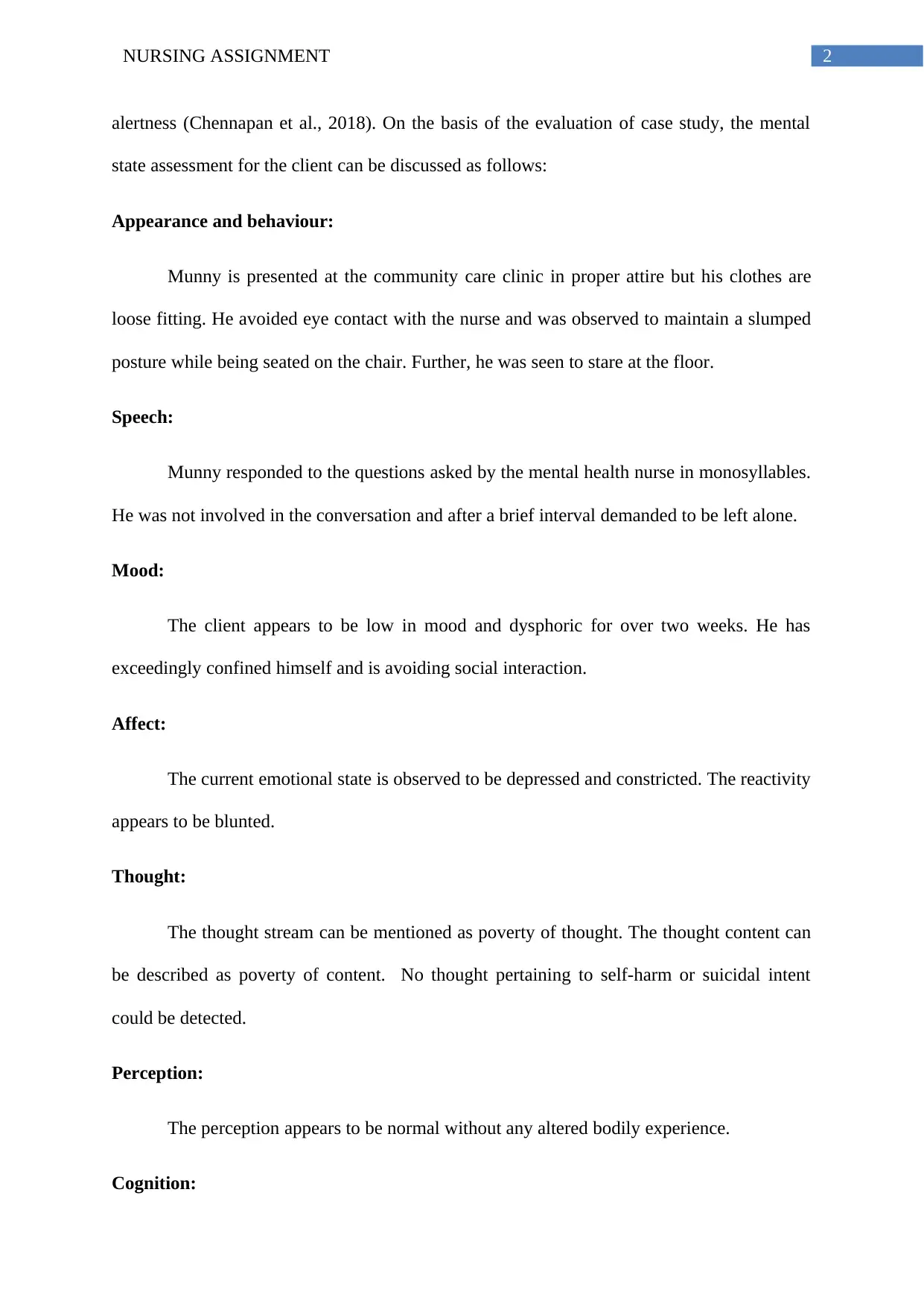
2NURSING ASSIGNMENT
alertness (Chennapan et al., 2018). On the basis of the evaluation of case study, the mental
state assessment for the client can be discussed as follows:
Appearance and behaviour:
Munny is presented at the community care clinic in proper attire but his clothes are
loose fitting. He avoided eye contact with the nurse and was observed to maintain a slumped
posture while being seated on the chair. Further, he was seen to stare at the floor.
Speech:
Munny responded to the questions asked by the mental health nurse in monosyllables.
He was not involved in the conversation and after a brief interval demanded to be left alone.
Mood:
The client appears to be low in mood and dysphoric for over two weeks. He has
exceedingly confined himself and is avoiding social interaction.
Affect:
The current emotional state is observed to be depressed and constricted. The reactivity
appears to be blunted.
Thought:
The thought stream can be mentioned as poverty of thought. The thought content can
be described as poverty of content. No thought pertaining to self-harm or suicidal intent
could be detected.
Perception:
The perception appears to be normal without any altered bodily experience.
Cognition:
alertness (Chennapan et al., 2018). On the basis of the evaluation of case study, the mental
state assessment for the client can be discussed as follows:
Appearance and behaviour:
Munny is presented at the community care clinic in proper attire but his clothes are
loose fitting. He avoided eye contact with the nurse and was observed to maintain a slumped
posture while being seated on the chair. Further, he was seen to stare at the floor.
Speech:
Munny responded to the questions asked by the mental health nurse in monosyllables.
He was not involved in the conversation and after a brief interval demanded to be left alone.
Mood:
The client appears to be low in mood and dysphoric for over two weeks. He has
exceedingly confined himself and is avoiding social interaction.
Affect:
The current emotional state is observed to be depressed and constricted. The reactivity
appears to be blunted.
Thought:
The thought stream can be mentioned as poverty of thought. The thought content can
be described as poverty of content. No thought pertaining to self-harm or suicidal intent
could be detected.
Perception:
The perception appears to be normal without any altered bodily experience.
Cognition:
⊘ This is a preview!⊘
Do you want full access?
Subscribe today to unlock all pages.

Trusted by 1+ million students worldwide

3NURSING ASSIGNMENT
The client appears to be alert and oriented to the situation.
Insight and Judgment:
Insight and judgment of the patient appears to be intact.
Therefore, on the basis of the evaluation of the case scenario, it can be mentioned that
persisting dysphoria, reduced social interaction and lack of interest in everyday activities
indicate the diagnosis of Depression. Further, as per the DSM V diagnostic criteria, the
persistent depressed mood of the patient, significant weight loss, increased feeling of fatigue,
lack of energy, reduced interest in regular activities confirm the diagnosis of Depression.
Research Studies state that the DSM 5 criteria outlines the characteristic symptoms that
confirm the diagnosis of Depression. In addition to this, it is also mentioned that for the
confirmatory diagnosis of Depression a client must experience lack of pleasure in usual
activities and a depressed mood for more than 2 weeks and five of the total eight symptoms
associated with depression (Lipskaya-Velikovsky et al., 2017; Grant et al., 2015).
Response 2:
According to Duckers et al. (2017), the stress vulnerability can be explained as the
biological model which helps to understand the cause of a mental illness. Research studies
mention that the model is effective to understand the nature of psychiatric disorders and how
co-occurring disorders are linked to one another (Nahum-Shani et al., 2015). The stress
vulnerability model comprises of two factors that involves, the vulnerability trait to acquire a
mental health disorder and stress that is associated with the challenges experienced in life or
the life stressors that trigger a mental health disorder (Swearer & Hymel, 2015). Vulnerability
primarily refers to the genetic construct of an individual to acquire a mental health disorder or
the characteristic lifestyle disorders that trigger the onset of a mental health disorder. On the
other hand, stress refers to the external life stressors that negatively impact the coping skills
The client appears to be alert and oriented to the situation.
Insight and Judgment:
Insight and judgment of the patient appears to be intact.
Therefore, on the basis of the evaluation of the case scenario, it can be mentioned that
persisting dysphoria, reduced social interaction and lack of interest in everyday activities
indicate the diagnosis of Depression. Further, as per the DSM V diagnostic criteria, the
persistent depressed mood of the patient, significant weight loss, increased feeling of fatigue,
lack of energy, reduced interest in regular activities confirm the diagnosis of Depression.
Research Studies state that the DSM 5 criteria outlines the characteristic symptoms that
confirm the diagnosis of Depression. In addition to this, it is also mentioned that for the
confirmatory diagnosis of Depression a client must experience lack of pleasure in usual
activities and a depressed mood for more than 2 weeks and five of the total eight symptoms
associated with depression (Lipskaya-Velikovsky et al., 2017; Grant et al., 2015).
Response 2:
According to Duckers et al. (2017), the stress vulnerability can be explained as the
biological model which helps to understand the cause of a mental illness. Research studies
mention that the model is effective to understand the nature of psychiatric disorders and how
co-occurring disorders are linked to one another (Nahum-Shani et al., 2015). The stress
vulnerability model comprises of two factors that involves, the vulnerability trait to acquire a
mental health disorder and stress that is associated with the challenges experienced in life or
the life stressors that trigger a mental health disorder (Swearer & Hymel, 2015). Vulnerability
primarily refers to the genetic construct of an individual to acquire a mental health disorder or
the characteristic lifestyle disorders that trigger the onset of a mental health disorder. On the
other hand, stress refers to the external life stressors that negatively impact the coping skills
Paraphrase This Document
Need a fresh take? Get an instant paraphrase of this document with our AI Paraphraser
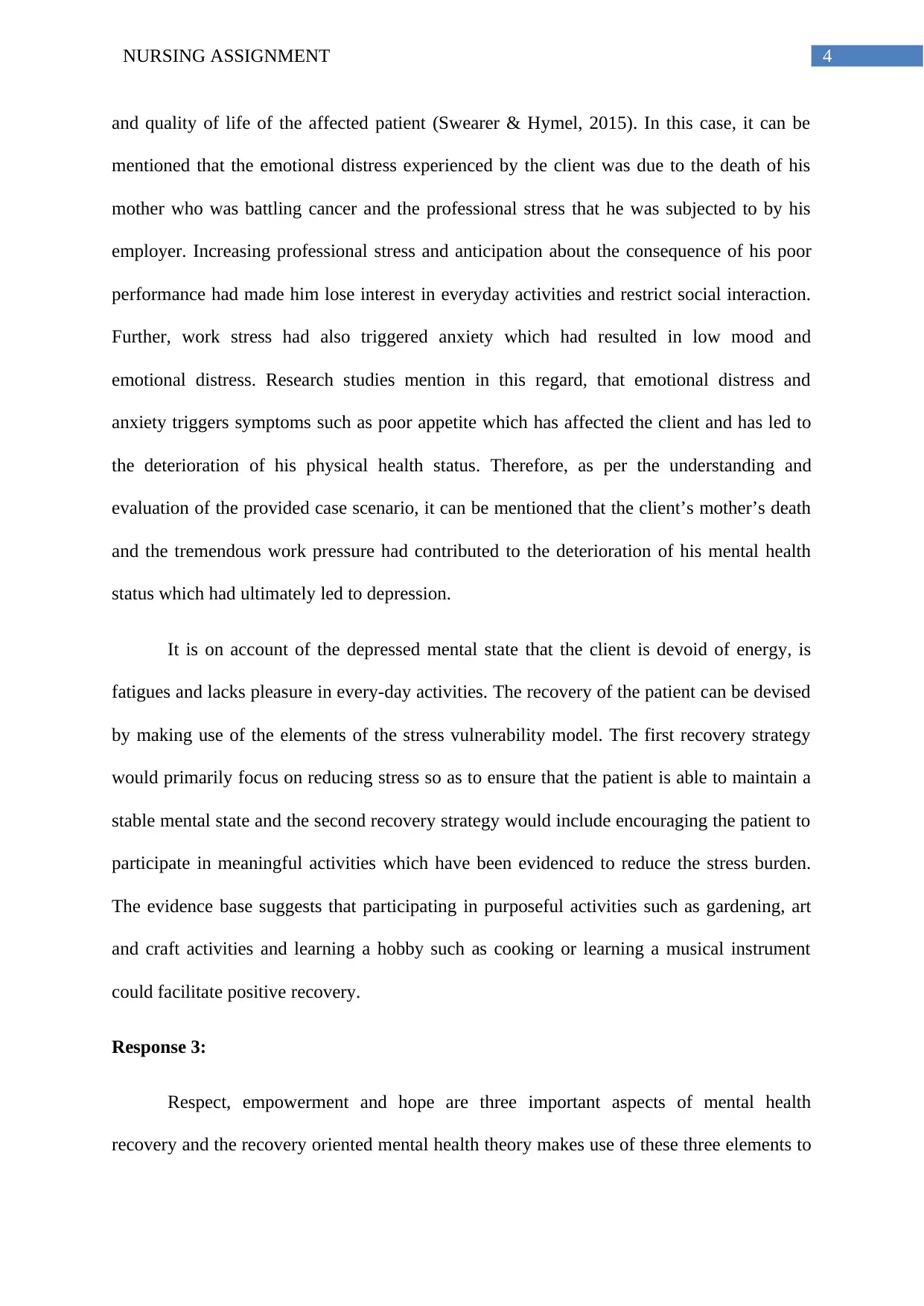
4NURSING ASSIGNMENT
and quality of life of the affected patient (Swearer & Hymel, 2015). In this case, it can be
mentioned that the emotional distress experienced by the client was due to the death of his
mother who was battling cancer and the professional stress that he was subjected to by his
employer. Increasing professional stress and anticipation about the consequence of his poor
performance had made him lose interest in everyday activities and restrict social interaction.
Further, work stress had also triggered anxiety which had resulted in low mood and
emotional distress. Research studies mention in this regard, that emotional distress and
anxiety triggers symptoms such as poor appetite which has affected the client and has led to
the deterioration of his physical health status. Therefore, as per the understanding and
evaluation of the provided case scenario, it can be mentioned that the client’s mother’s death
and the tremendous work pressure had contributed to the deterioration of his mental health
status which had ultimately led to depression.
It is on account of the depressed mental state that the client is devoid of energy, is
fatigues and lacks pleasure in every-day activities. The recovery of the patient can be devised
by making use of the elements of the stress vulnerability model. The first recovery strategy
would primarily focus on reducing stress so as to ensure that the patient is able to maintain a
stable mental state and the second recovery strategy would include encouraging the patient to
participate in meaningful activities which have been evidenced to reduce the stress burden.
The evidence base suggests that participating in purposeful activities such as gardening, art
and craft activities and learning a hobby such as cooking or learning a musical instrument
could facilitate positive recovery.
Response 3:
Respect, empowerment and hope are three important aspects of mental health
recovery and the recovery oriented mental health theory makes use of these three elements to
and quality of life of the affected patient (Swearer & Hymel, 2015). In this case, it can be
mentioned that the emotional distress experienced by the client was due to the death of his
mother who was battling cancer and the professional stress that he was subjected to by his
employer. Increasing professional stress and anticipation about the consequence of his poor
performance had made him lose interest in everyday activities and restrict social interaction.
Further, work stress had also triggered anxiety which had resulted in low mood and
emotional distress. Research studies mention in this regard, that emotional distress and
anxiety triggers symptoms such as poor appetite which has affected the client and has led to
the deterioration of his physical health status. Therefore, as per the understanding and
evaluation of the provided case scenario, it can be mentioned that the client’s mother’s death
and the tremendous work pressure had contributed to the deterioration of his mental health
status which had ultimately led to depression.
It is on account of the depressed mental state that the client is devoid of energy, is
fatigues and lacks pleasure in every-day activities. The recovery of the patient can be devised
by making use of the elements of the stress vulnerability model. The first recovery strategy
would primarily focus on reducing stress so as to ensure that the patient is able to maintain a
stable mental state and the second recovery strategy would include encouraging the patient to
participate in meaningful activities which have been evidenced to reduce the stress burden.
The evidence base suggests that participating in purposeful activities such as gardening, art
and craft activities and learning a hobby such as cooking or learning a musical instrument
could facilitate positive recovery.
Response 3:
Respect, empowerment and hope are three important aspects of mental health
recovery and the recovery oriented mental health theory makes use of these three elements to
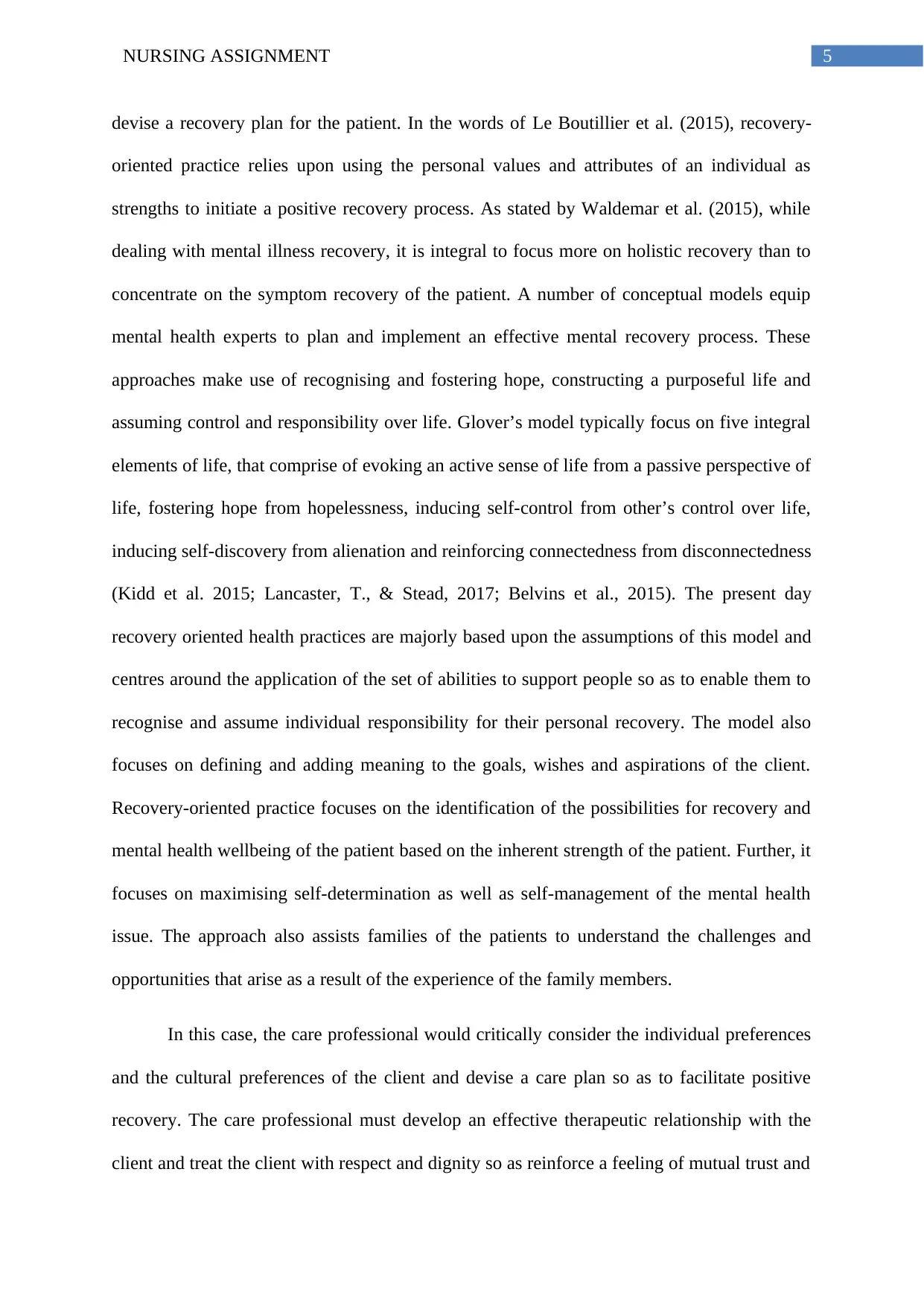
5NURSING ASSIGNMENT
devise a recovery plan for the patient. In the words of Le Boutillier et al. (2015), recovery-
oriented practice relies upon using the personal values and attributes of an individual as
strengths to initiate a positive recovery process. As stated by Waldemar et al. (2015), while
dealing with mental illness recovery, it is integral to focus more on holistic recovery than to
concentrate on the symptom recovery of the patient. A number of conceptual models equip
mental health experts to plan and implement an effective mental recovery process. These
approaches make use of recognising and fostering hope, constructing a purposeful life and
assuming control and responsibility over life. Glover’s model typically focus on five integral
elements of life, that comprise of evoking an active sense of life from a passive perspective of
life, fostering hope from hopelessness, inducing self-control from other’s control over life,
inducing self-discovery from alienation and reinforcing connectedness from disconnectedness
(Kidd et al. 2015; Lancaster, T., & Stead, 2017; Belvins et al., 2015). The present day
recovery oriented health practices are majorly based upon the assumptions of this model and
centres around the application of the set of abilities to support people so as to enable them to
recognise and assume individual responsibility for their personal recovery. The model also
focuses on defining and adding meaning to the goals, wishes and aspirations of the client.
Recovery-oriented practice focuses on the identification of the possibilities for recovery and
mental health wellbeing of the patient based on the inherent strength of the patient. Further, it
focuses on maximising self-determination as well as self-management of the mental health
issue. The approach also assists families of the patients to understand the challenges and
opportunities that arise as a result of the experience of the family members.
In this case, the care professional would critically consider the individual preferences
and the cultural preferences of the client and devise a care plan so as to facilitate positive
recovery. The care professional must develop an effective therapeutic relationship with the
client and treat the client with respect and dignity so as reinforce a feeling of mutual trust and
devise a recovery plan for the patient. In the words of Le Boutillier et al. (2015), recovery-
oriented practice relies upon using the personal values and attributes of an individual as
strengths to initiate a positive recovery process. As stated by Waldemar et al. (2015), while
dealing with mental illness recovery, it is integral to focus more on holistic recovery than to
concentrate on the symptom recovery of the patient. A number of conceptual models equip
mental health experts to plan and implement an effective mental recovery process. These
approaches make use of recognising and fostering hope, constructing a purposeful life and
assuming control and responsibility over life. Glover’s model typically focus on five integral
elements of life, that comprise of evoking an active sense of life from a passive perspective of
life, fostering hope from hopelessness, inducing self-control from other’s control over life,
inducing self-discovery from alienation and reinforcing connectedness from disconnectedness
(Kidd et al. 2015; Lancaster, T., & Stead, 2017; Belvins et al., 2015). The present day
recovery oriented health practices are majorly based upon the assumptions of this model and
centres around the application of the set of abilities to support people so as to enable them to
recognise and assume individual responsibility for their personal recovery. The model also
focuses on defining and adding meaning to the goals, wishes and aspirations of the client.
Recovery-oriented practice focuses on the identification of the possibilities for recovery and
mental health wellbeing of the patient based on the inherent strength of the patient. Further, it
focuses on maximising self-determination as well as self-management of the mental health
issue. The approach also assists families of the patients to understand the challenges and
opportunities that arise as a result of the experience of the family members.
In this case, the care professional would critically consider the individual preferences
and the cultural preferences of the client and devise a care plan so as to facilitate positive
recovery. The care professional must develop an effective therapeutic relationship with the
client and treat the client with respect and dignity so as reinforce a feeling of mutual trust and
⊘ This is a preview!⊘
Do you want full access?
Subscribe today to unlock all pages.

Trusted by 1+ million students worldwide
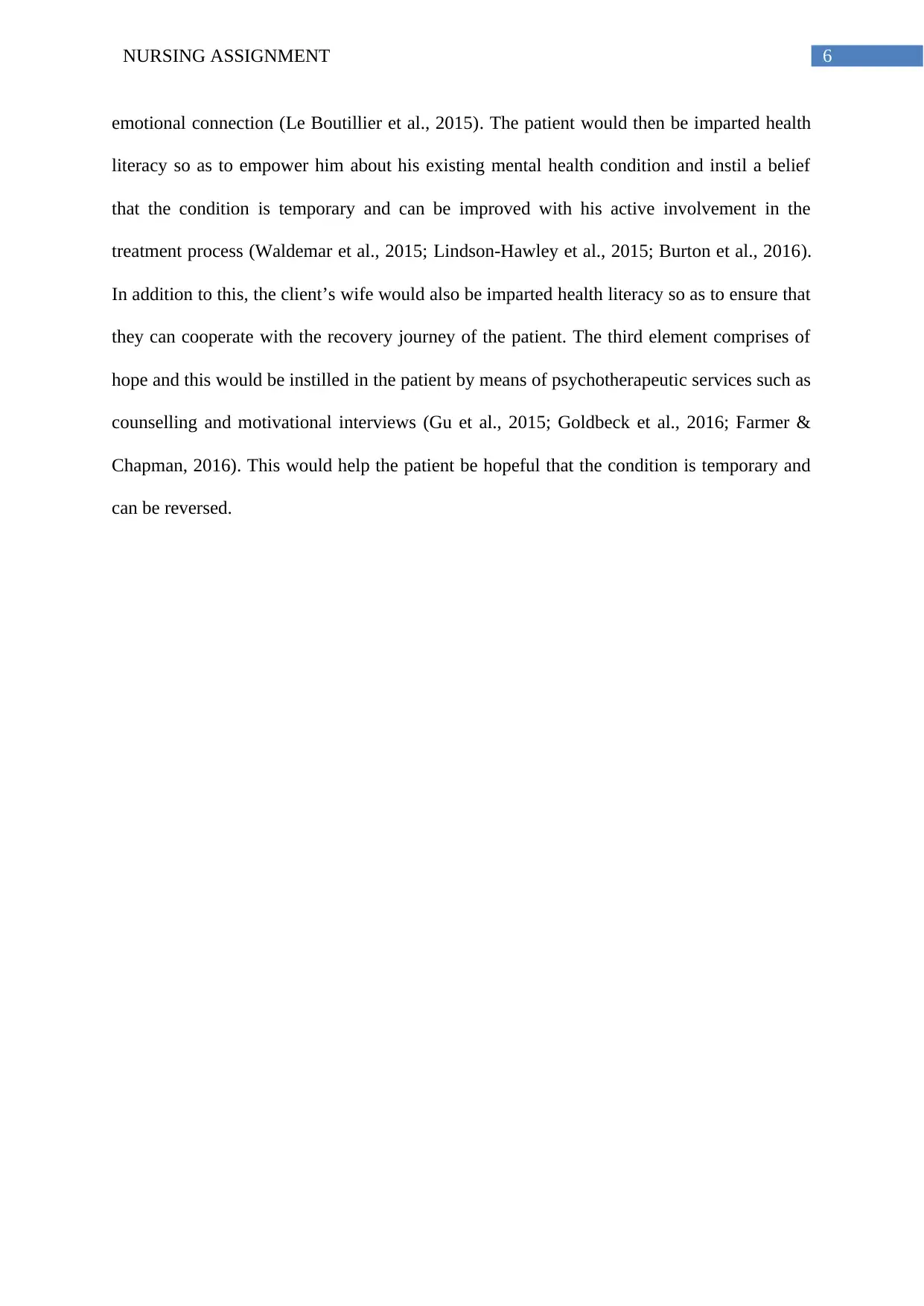
6NURSING ASSIGNMENT
emotional connection (Le Boutillier et al., 2015). The patient would then be imparted health
literacy so as to empower him about his existing mental health condition and instil a belief
that the condition is temporary and can be improved with his active involvement in the
treatment process (Waldemar et al., 2015; Lindson‐Hawley et al., 2015; Burton et al., 2016).
In addition to this, the client’s wife would also be imparted health literacy so as to ensure that
they can cooperate with the recovery journey of the patient. The third element comprises of
hope and this would be instilled in the patient by means of psychotherapeutic services such as
counselling and motivational interviews (Gu et al., 2015; Goldbeck et al., 2016; Farmer &
Chapman, 2016). This would help the patient be hopeful that the condition is temporary and
can be reversed.
emotional connection (Le Boutillier et al., 2015). The patient would then be imparted health
literacy so as to empower him about his existing mental health condition and instil a belief
that the condition is temporary and can be improved with his active involvement in the
treatment process (Waldemar et al., 2015; Lindson‐Hawley et al., 2015; Burton et al., 2016).
In addition to this, the client’s wife would also be imparted health literacy so as to ensure that
they can cooperate with the recovery journey of the patient. The third element comprises of
hope and this would be instilled in the patient by means of psychotherapeutic services such as
counselling and motivational interviews (Gu et al., 2015; Goldbeck et al., 2016; Farmer &
Chapman, 2016). This would help the patient be hopeful that the condition is temporary and
can be reversed.
Paraphrase This Document
Need a fresh take? Get an instant paraphrase of this document with our AI Paraphraser
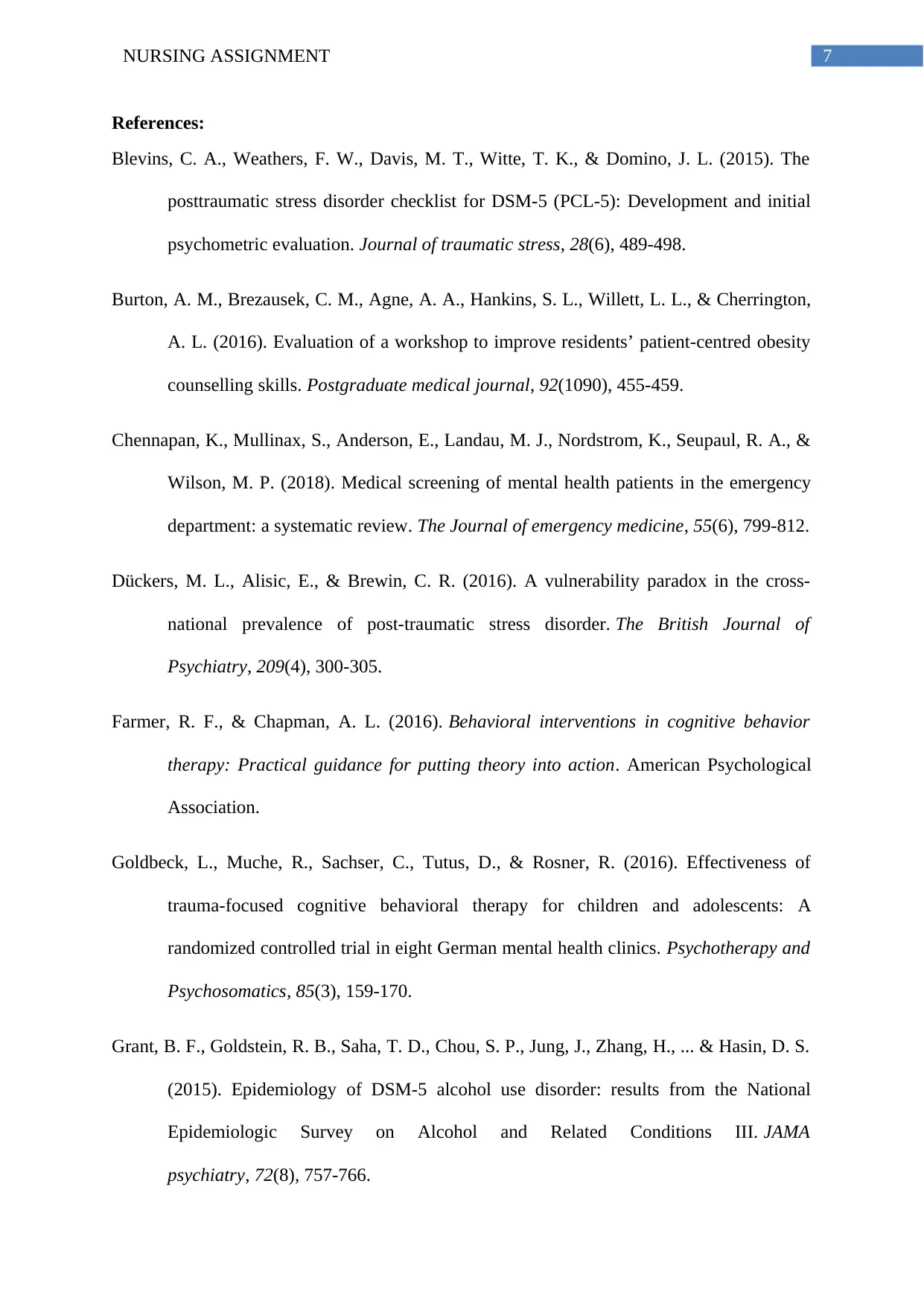
7NURSING ASSIGNMENT
References:
Blevins, C. A., Weathers, F. W., Davis, M. T., Witte, T. K., & Domino, J. L. (2015). The
posttraumatic stress disorder checklist for DSM‐5 (PCL‐5): Development and initial
psychometric evaluation. Journal of traumatic stress, 28(6), 489-498.
Burton, A. M., Brezausek, C. M., Agne, A. A., Hankins, S. L., Willett, L. L., & Cherrington,
A. L. (2016). Evaluation of a workshop to improve residents’ patient-centred obesity
counselling skills. Postgraduate medical journal, 92(1090), 455-459.
Chennapan, K., Mullinax, S., Anderson, E., Landau, M. J., Nordstrom, K., Seupaul, R. A., &
Wilson, M. P. (2018). Medical screening of mental health patients in the emergency
department: a systematic review. The Journal of emergency medicine, 55(6), 799-812.
Dückers, M. L., Alisic, E., & Brewin, C. R. (2016). A vulnerability paradox in the cross-
national prevalence of post-traumatic stress disorder. The British Journal of
Psychiatry, 209(4), 300-305.
Farmer, R. F., & Chapman, A. L. (2016). Behavioral interventions in cognitive behavior
therapy: Practical guidance for putting theory into action. American Psychological
Association.
Goldbeck, L., Muche, R., Sachser, C., Tutus, D., & Rosner, R. (2016). Effectiveness of
trauma-focused cognitive behavioral therapy for children and adolescents: A
randomized controlled trial in eight German mental health clinics. Psychotherapy and
Psychosomatics, 85(3), 159-170.
Grant, B. F., Goldstein, R. B., Saha, T. D., Chou, S. P., Jung, J., Zhang, H., ... & Hasin, D. S.
(2015). Epidemiology of DSM-5 alcohol use disorder: results from the National
Epidemiologic Survey on Alcohol and Related Conditions III. JAMA
psychiatry, 72(8), 757-766.
References:
Blevins, C. A., Weathers, F. W., Davis, M. T., Witte, T. K., & Domino, J. L. (2015). The
posttraumatic stress disorder checklist for DSM‐5 (PCL‐5): Development and initial
psychometric evaluation. Journal of traumatic stress, 28(6), 489-498.
Burton, A. M., Brezausek, C. M., Agne, A. A., Hankins, S. L., Willett, L. L., & Cherrington,
A. L. (2016). Evaluation of a workshop to improve residents’ patient-centred obesity
counselling skills. Postgraduate medical journal, 92(1090), 455-459.
Chennapan, K., Mullinax, S., Anderson, E., Landau, M. J., Nordstrom, K., Seupaul, R. A., &
Wilson, M. P. (2018). Medical screening of mental health patients in the emergency
department: a systematic review. The Journal of emergency medicine, 55(6), 799-812.
Dückers, M. L., Alisic, E., & Brewin, C. R. (2016). A vulnerability paradox in the cross-
national prevalence of post-traumatic stress disorder. The British Journal of
Psychiatry, 209(4), 300-305.
Farmer, R. F., & Chapman, A. L. (2016). Behavioral interventions in cognitive behavior
therapy: Practical guidance for putting theory into action. American Psychological
Association.
Goldbeck, L., Muche, R., Sachser, C., Tutus, D., & Rosner, R. (2016). Effectiveness of
trauma-focused cognitive behavioral therapy for children and adolescents: A
randomized controlled trial in eight German mental health clinics. Psychotherapy and
Psychosomatics, 85(3), 159-170.
Grant, B. F., Goldstein, R. B., Saha, T. D., Chou, S. P., Jung, J., Zhang, H., ... & Hasin, D. S.
(2015). Epidemiology of DSM-5 alcohol use disorder: results from the National
Epidemiologic Survey on Alcohol and Related Conditions III. JAMA
psychiatry, 72(8), 757-766.
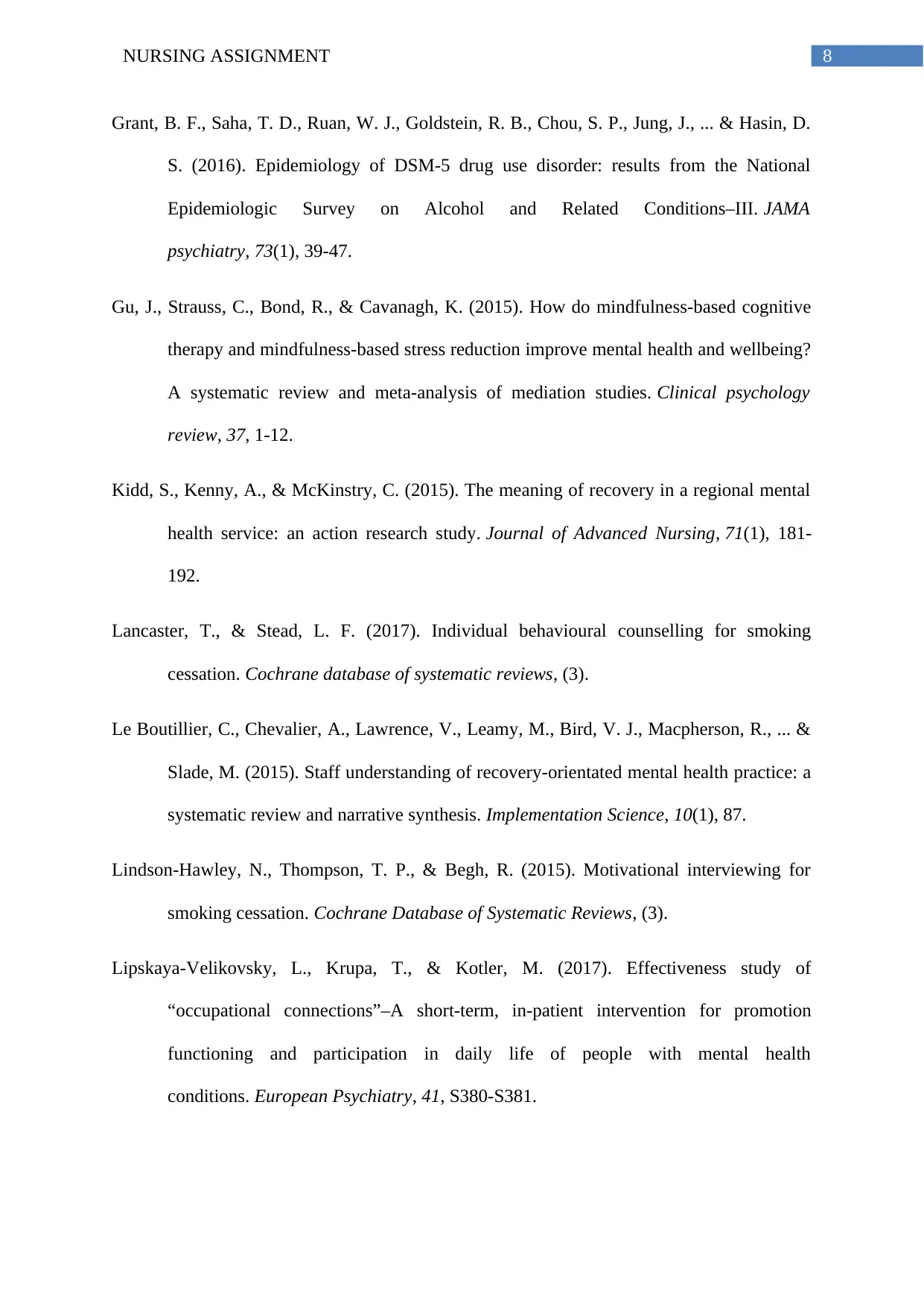
8NURSING ASSIGNMENT
Grant, B. F., Saha, T. D., Ruan, W. J., Goldstein, R. B., Chou, S. P., Jung, J., ... & Hasin, D.
S. (2016). Epidemiology of DSM-5 drug use disorder: results from the National
Epidemiologic Survey on Alcohol and Related Conditions–III. JAMA
psychiatry, 73(1), 39-47.
Gu, J., Strauss, C., Bond, R., & Cavanagh, K. (2015). How do mindfulness-based cognitive
therapy and mindfulness-based stress reduction improve mental health and wellbeing?
A systematic review and meta-analysis of mediation studies. Clinical psychology
review, 37, 1-12.
Kidd, S., Kenny, A., & McKinstry, C. (2015). The meaning of recovery in a regional mental
health service: an action research study. Journal of Advanced Nursing, 71(1), 181-
192.
Lancaster, T., & Stead, L. F. (2017). Individual behavioural counselling for smoking
cessation. Cochrane database of systematic reviews, (3).
Le Boutillier, C., Chevalier, A., Lawrence, V., Leamy, M., Bird, V. J., Macpherson, R., ... &
Slade, M. (2015). Staff understanding of recovery-orientated mental health practice: a
systematic review and narrative synthesis. Implementation Science, 10(1), 87.
Lindson‐Hawley, N., Thompson, T. P., & Begh, R. (2015). Motivational interviewing for
smoking cessation. Cochrane Database of Systematic Reviews, (3).
Lipskaya-Velikovsky, L., Krupa, T., & Kotler, M. (2017). Effectiveness study of
“occupational connections”–A short-term, in-patient intervention for promotion
functioning and participation in daily life of people with mental health
conditions. European Psychiatry, 41, S380-S381.
Grant, B. F., Saha, T. D., Ruan, W. J., Goldstein, R. B., Chou, S. P., Jung, J., ... & Hasin, D.
S. (2016). Epidemiology of DSM-5 drug use disorder: results from the National
Epidemiologic Survey on Alcohol and Related Conditions–III. JAMA
psychiatry, 73(1), 39-47.
Gu, J., Strauss, C., Bond, R., & Cavanagh, K. (2015). How do mindfulness-based cognitive
therapy and mindfulness-based stress reduction improve mental health and wellbeing?
A systematic review and meta-analysis of mediation studies. Clinical psychology
review, 37, 1-12.
Kidd, S., Kenny, A., & McKinstry, C. (2015). The meaning of recovery in a regional mental
health service: an action research study. Journal of Advanced Nursing, 71(1), 181-
192.
Lancaster, T., & Stead, L. F. (2017). Individual behavioural counselling for smoking
cessation. Cochrane database of systematic reviews, (3).
Le Boutillier, C., Chevalier, A., Lawrence, V., Leamy, M., Bird, V. J., Macpherson, R., ... &
Slade, M. (2015). Staff understanding of recovery-orientated mental health practice: a
systematic review and narrative synthesis. Implementation Science, 10(1), 87.
Lindson‐Hawley, N., Thompson, T. P., & Begh, R. (2015). Motivational interviewing for
smoking cessation. Cochrane Database of Systematic Reviews, (3).
Lipskaya-Velikovsky, L., Krupa, T., & Kotler, M. (2017). Effectiveness study of
“occupational connections”–A short-term, in-patient intervention for promotion
functioning and participation in daily life of people with mental health
conditions. European Psychiatry, 41, S380-S381.
⊘ This is a preview!⊘
Do you want full access?
Subscribe today to unlock all pages.

Trusted by 1+ million students worldwide
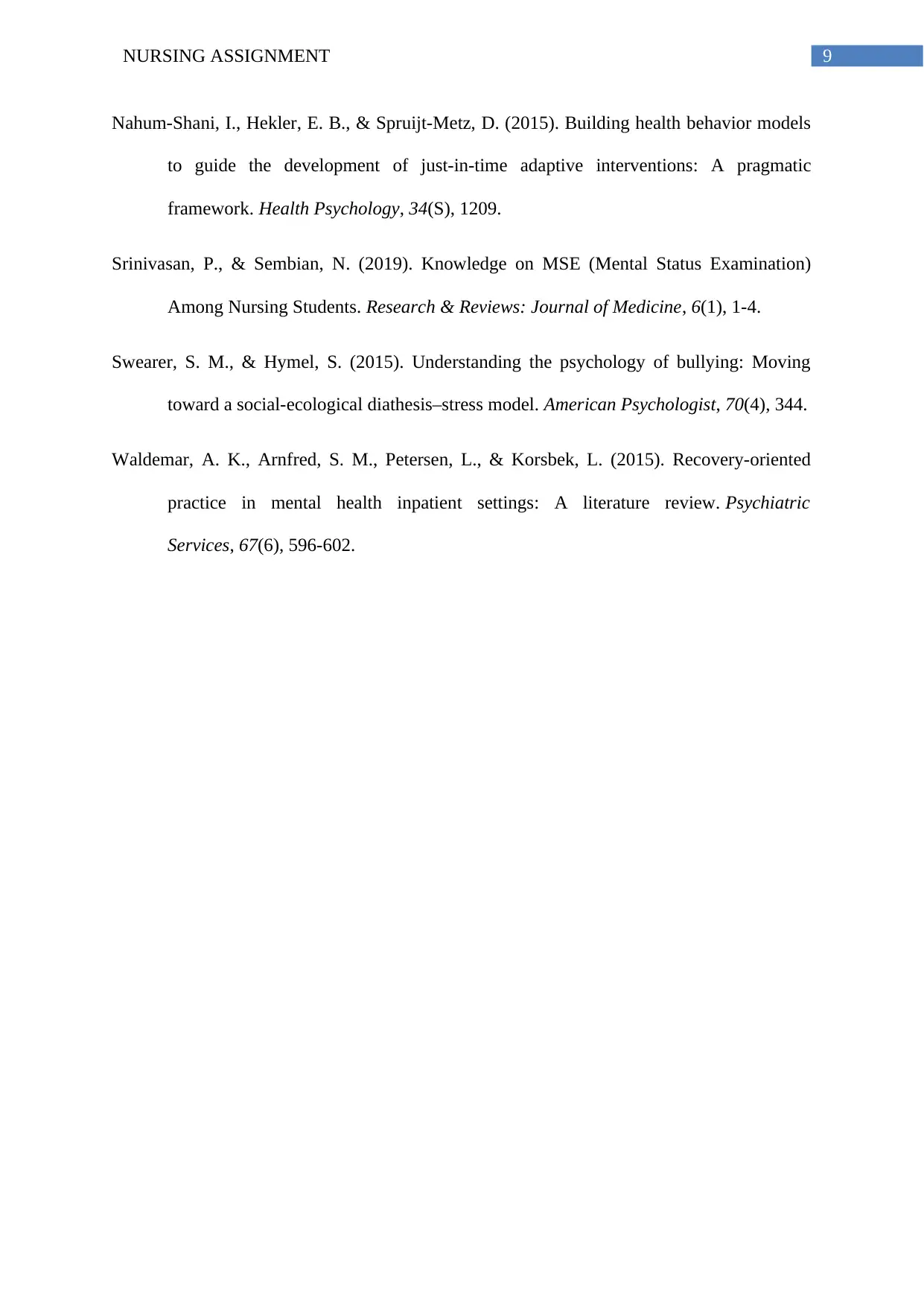
9NURSING ASSIGNMENT
Nahum-Shani, I., Hekler, E. B., & Spruijt-Metz, D. (2015). Building health behavior models
to guide the development of just-in-time adaptive interventions: A pragmatic
framework. Health Psychology, 34(S), 1209.
Srinivasan, P., & Sembian, N. (2019). Knowledge on MSE (Mental Status Examination)
Among Nursing Students. Research & Reviews: Journal of Medicine, 6(1), 1-4.
Swearer, S. M., & Hymel, S. (2015). Understanding the psychology of bullying: Moving
toward a social-ecological diathesis–stress model. American Psychologist, 70(4), 344.
Waldemar, A. K., Arnfred, S. M., Petersen, L., & Korsbek, L. (2015). Recovery-oriented
practice in mental health inpatient settings: A literature review. Psychiatric
Services, 67(6), 596-602.
Nahum-Shani, I., Hekler, E. B., & Spruijt-Metz, D. (2015). Building health behavior models
to guide the development of just-in-time adaptive interventions: A pragmatic
framework. Health Psychology, 34(S), 1209.
Srinivasan, P., & Sembian, N. (2019). Knowledge on MSE (Mental Status Examination)
Among Nursing Students. Research & Reviews: Journal of Medicine, 6(1), 1-4.
Swearer, S. M., & Hymel, S. (2015). Understanding the psychology of bullying: Moving
toward a social-ecological diathesis–stress model. American Psychologist, 70(4), 344.
Waldemar, A. K., Arnfred, S. M., Petersen, L., & Korsbek, L. (2015). Recovery-oriented
practice in mental health inpatient settings: A literature review. Psychiatric
Services, 67(6), 596-602.
1 out of 10
Related Documents
Your All-in-One AI-Powered Toolkit for Academic Success.
+13062052269
info@desklib.com
Available 24*7 on WhatsApp / Email
![[object Object]](/_next/static/media/star-bottom.7253800d.svg)
Unlock your academic potential
Copyright © 2020–2025 A2Z Services. All Rights Reserved. Developed and managed by ZUCOL.





